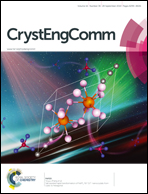Two unusual organic–inorganic hybrid 3-D frameworks based on Keggin-type heteropoly blue anion-chains, 40-membered macrocycles, and sodium linker units†
Abstract
Two novel 3D compounds based on Keggin heteropoly blue anion-chains, [Na(H2O)2{MI(btp)}4(PWVI8WV4O39)] (M = Cu (1), Ag (2), btp = 1,3-bis(1,2,4-triazol-1-yl)propane), have been hydrothermally synthesized and characterized by elemental analysis, IR, TG, PXRD and single crystal X-ray diffraction. In compounds 1 and 2, the neighboring Keggin clusters are connected via sharing terminal oxygen atoms to form unusual Keggin anion chains by W–O–W covalent interactions, which are further reinforced by two copper(I) or silver(I) bridging fragments. Such saturated Keggin anion chains have been observed for the first time. The (Mbtp)4 40-membered cation-macrocycles and {Na(H2O)2} units serve as linkers to bond two adjacent anion chains resulting in infinite 2-D layers. The layers are further fused by interactions between the 40-membered macrocycles and {Na(H2O)2} units leading to intricate 3-D frameworks, which exhibit a novel 4, 6, 8-connected topology. In addition, compounds 1 and 2 exhibit good electrocatalytic activity for reduction of nitrite and fluorescence properties in the solid state at room temperature.


 Please wait while we load your content...
Please wait while we load your content...